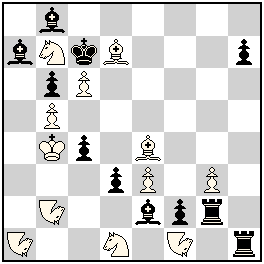|
No.477 Welcome to Miodrag in Original Problems section of Julia’s Fairies! |
Original Problems, Julia’s Fairies – 2014 (I): January – April →Previous ; →Next ; →List 2014(I) Please send your original fairy problems to: julia@juliasfairies.com |
No.477 by Miodrag Mladenović – A modern Fairy #3 showing Zagoruiko theme! Warm welcome to Miodrag! (JV)
Definitions:
Nightrider(N): (1,2) Rider. Operates along straight lines with squares lying a Knight’s move away from each other.
|
No.477 Miodrag Mladenović
Serbia
original-04.01.2014
 #3*v (12+11)
Nightriders: a1, b2, f1 Solution: (click to show/hide)
|



The strategical mechanism of the problem is the same as in the orthodox #3 by Milan Velimirović (although in YACPDB no set play or tries are given right now, the solution should be written as given below). Shortly speaking, two black defenders withdraw from their defending lines, one or more for each of them. The defending lines are intersecting on squares where the key piece stands in the set play, try and solution. They are arranged so that always after defence one of three quiet continuations can be played without any effective defence by thematical defenders to threatened checkmates, in a cyclical fashion.
I’m not claiming anticipation, it is just another rendering of the mechanism, with new arrangement of thematical lines and mates.
———————————————-
1…Rxb2 a 2.Be6 A [3.Bxf5#] Bd7 3.Bf7#
1…Qa1 b 2.c8=S B [3.Se7#]
1.Bd6? [2.Qxf6+ gxf6 3.Rg8#]
1…Rxb2 a 2.c8=S B [3.Se7#]
1…Qa1 b 2.Sf3 C [3.Sh4#]
1…Sd7!
1.Bf4! [2.Qxf6+ gxf6 3.Rg8#]
1…Rxb2 a 2.Sf3 C [3.Sh4#]
1…Qa1 b 2.Be6 A [3.Bxf5#] Bd7 3.Bf7#
(1…Sd7 2.Sf3 [3.Sh4#])
Yes, indeed!
An excellent rendering of Milan’s great mechanism.. I remember commenting about it in matplus when he got the GM title..
The mechanism is quite simple, yet profound..there doesn’t seem to be another orthodox example..
Miodrag uses the basic R/B lines complex.. with a WB sitting on the intersection points..
The nightriders really aren’t part of the mechanism, though they’re needed for the threat and continuations..
Both W and B have a pair of same colour Bishops.. which is (used to be?) a slight flaw..
Interesting would be a rendering using N, rose or other kinds of fairy lines..
I would say “used to be”! With fairy pieces on the board, there is no logical reason why extra orthodox pieces should be a flaw (three white N’s is OK but not three black B’s ?!). If anything, an extra orthodox piece is more economical than an extra fairy piece.
I would even argue that “promoted pieces” should not be considered a flaw in any kind of fairy chess, neither with unorthodox rules nor with unorthodox stipulations. What counts is only how well the pieces on the board are used.
I share the Kjell view on the additional orthodox pieces in the problem with fairy pieces. Once fairy pieces are used, additional orthodox pieces do not mean any flaw for me. But this view is not shared by everybody, even among judges of fairy tourneys sometimes penalize use of promoted orthodox force (one example of many).
The position of the white bishop determines which of the squares is unguarded by the black defence. Beautiful mechanism even if invented by another composer. Great rendition of the ‘Rice’ theme !
Here’s a geometric comparison..
[img]https://db.tt/tsHhNSyB[/img]
Excellent picture. I am sure some other renderings of the mechanism with different arrangement of lines are possible and similar pictures can be very instructive in explaining the underlying mechanism.
By the way, this demonstrates that behind alphabetic theme there can very unified and valuable strategy, something often forgotten by critics of alphabetic problems.